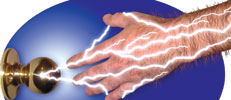Static eliminators used to remedy common static problems
July 2012
Electrical Power & Protection

Static electricity causes problems when the temperature and humidity drops. The types of problems that can be expected in production facilities are:
* Materials tearing, jamming or curling.
* Webs and films clinging to themselves.
* Electronic sensors failing, thereby causing false readings.
* Dust attraction ruining surface finishes.
* Product clinging to itself, rollers and machine beds.
* Hazardous sparks or shocks.
Charged conductors, for example metals, discharge completely when grounded while insulators like plastic, do not conduct static electricity. The use of carbon brushes or grounded tinsel to ground machinery has little effect on these surfaces.
EXAIR manufactures a complete range of static eliminators to remedy common static problems. The Super Ion Air Knife, with its curtain of laminar airflow, is recommended for applications involving high speeds, large surfaces or complex geometries. It is effective up to 6 m. The manufacturer avers that it provides the best performance of all ionisers. Other static eliminators include the Air Cannon, the Ion Air Gun and the Ion Air Jet. The entire range use the manufacturer’s engineered airflow products to minimise air use and noise while effectively eliminating static by moving more ions to the product surface.
In applications where airflow will possibly disturb the product, the manufacturer’s Ionising Bars and Ionising Point can neutralise the charge when mounted within a couple of centimetres of the surface do not require airflow.
It is often difficult to isolate the source of the static but EXAIR’s handheld, digital Static Meter can be used to locate its source and severity. The meter indicates the surface voltage and polarity up to 20 kV measured at a distance of 25 mm. Features include a pushbutton ‘hold’ for readings and automatic ‘power off’. It is supplied with a hard shell case and calibration certificate traceable to NIST (National Institute of Standards and Technology).
The Static Meter can also be used to demonstrate that an ioniser is functioning by first measuring the charge on the product surface with the meter, then exposing the product to the ionised airflow and finally measuring the charge on the product surface again. The ioniser is functioning properly if the charge reads 0 volts.
If the charge remains on the product surface, it should be verified that the ioniser is connected properly to a grounded power supply. It is also possible that the ioniser has become dirty, in which case, cleaning by scrubbing any dust and contaminants with a small brush is required. Cleaning with chemical is not recommended as some chemicals are conductive and create a conductive path from the emitter to the grounded surface. Flammability of certain solvents is also an issue.
For more information contact Rodney or Alan, ETEST, (0)31 702 8302, [email protected], www.etest.co.za
Further reading:
Energy audits pave the pathway to sustainability and savings
Schneider Electric South Africa
Electrical Power & Protection
Energy audits serve as essential tools for businesses looking to reduce costs and meet environmental targets. By analysing energy consumption across systems such as lighting, HVAC, ICT and water infrastructure, audits identify inefficiencies and quantify carbon footprints, enabling data-driven decisions for operational and financial optimisation.
Read more...
Passive fire protection for lithium-ion battery risks
Electrical Power & Protection
In response to the growing threat posed by lithium-ion (Li-ion) battery fires, a breakthrough passive fire protection solution is now available in South Africa.
Read more...
Schneider Electric unveils new range of circuit breakers
Schneider Electric South Africa
Electrical Power & Protection
Schneider Electric has launched its new MasterPacT MTZ Active range of circuit breakers in South Africa. This is a revolutionary new circuit breaker designed to set new benchmarks for safety, efficiency and sustainability while ensuring business continuity.
Read more...
Reliable power for demanding applications
Conical Technologies
Electrical Power & Protection
In modern industrial automation, reliability, efficiency and compact design are critical when selecting power supplies. The Mibbo Power MTR480 three-phase DIN-rail power supply is engineered to meet these exacting requirements.
Read more...
Managing dynamic steam plant operation on a multi-user site
Electrical Power & Protection
Managing a dynamic steam plant operation featuring multiple users requires strong technical skills, good communication and close attention to optimising results. AES’s remote monitoring system gathers steam generation plant data and records critical operational monitoring parameters.
Read more...
South Africa’s journey to smart, greener transport
Schneider Electric South Africa
Electrical Power & Protection
The good news is that there are some truly feasible solutions that can assist in overcoming some of South Africa’s most pertinent transport electrification challenges.
Read more...
Precise, fast universal power and net quality meter
Vepac Electronics
Electrical Power & Protection
The eCap from Vepac measures voltages, currents, power, power factor, energy, frequency and total harmonic distortion (THD) with all harmonics (up to 20th), and allows fully galvanically isolated transmission via the integrated Modbus RTU/RS485 interface.
Read more...
Novel stacked capacitors
Electrical Power & Protection
KYOCERA AVXhas released the new DSCC 25007 Mini BME stacks. These are miniature, high-CV stacked X7R capacitors equipped with base metal electrodes (BME) and subjected to 100% Group A testing.
Read more...
Circuit breakers for reliable, compliant protection
Electrical Power & Protection
Legrand’s low-voltage power distribution portfolio encompasses the DX
3 range of miniature circuit breakers, designed to deliver dependable protection in industrial installations.
Read more...
Grid to backup power in zero seconds
Electrical Power & Protection
South Ocean Electric Wire has completed a solar installation that marks a global first: a seamless switch from grid to backup power in zero seconds.
Read more...


